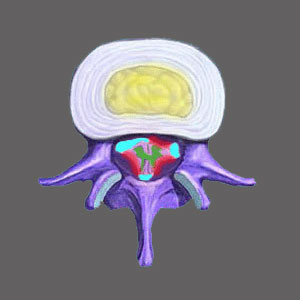
Hereditary spinal stenosis can be passed from one generation to the next via genetic material. While there is no singular specific gene that causes spinal stenosis, there are many spinal conditions and tendencies that can directly cause or contribute to the formation of stenosis and these conditions do have genetic markers which can be inherited.
Most people hope for an inheritance. However, when what they inherit is spinal stenosis, they might wish they never received this hereditary offering… If you are wondering about the how spinal stenosis can be passed down to children and grandchildren, then you are in the right place to learn.
This post details the link between heredity and spinal stenosis.
Hereditary Spinal Stenosis Defined
Hereditary means to be passed down from parent to child. Hereditary traits come in great variety and form the basis for who we are and largely who we will become, at least anatomically. We must make it clear right from the start that spinal stenosis does not have a singular gene that can be passed down. Stenosis has many possible causes and contributors and many of these factors do have genetic markers that might be inherited. Therefore, when stenosis tends to run in the family (which it often does), it is logical to conclude that some genetic material disposing the person to stenosis is passed down and eventually factors into the development of the condition.
We have already discussed the fine points of the genetics of spinal stenosis elsewhere, so please accept our invite to read that article to get more detailed information on how genes are inherited and why these genes might create the ideal circumstances for spinal stenosis to occur.
It is vital to remember that spinal stenosis is basically normal for humans to develop as they get older. The tendency for the spinal canal and foraminal spaces to narrow with age and activity is universal and expected.
Spinal Stenosis Genetic Contributors
The way a person’s spine will function, age and adapt to stress is largely dependent on the genetic information a person inherits from their ancestors. All of the following factors may be linked to inherited genes and might predispose a person towards developing typical or atypical spinal stenosis:
- Spinal disc issues, like degeneration and herniation, tend to run in family lines.
- Low bone density and osteoporosis can be inherited.
- All manner of atypical spinal curvatures can be genetically passed along.
- Osteoarthritis tends to run in families.
- Structural abnormalities (e.g. transitional, sacralized, hemi vertebra) can be inherited.
- Spondylolisthesis tends to run in family lines.
- General spinal degeneration tendencies can be hereditary.
In essence, many of the most common structural contributors to spinal canal narrowing may be passed won from generation to generation, making children equally susceptible to stenosis, just like their parents and grandparents.
Of note, some spinal tendencies are usually passed along on the female side of the family, while others tend to be passed along on the male side. This is why some conditions only affect some offspring or even skip a generation or 2, when offspring are not born of the gender more likely to carry specific inherited genes.
Hereditary Mindbody Spinal Stenosis
Just like the way structural traits can be passed down from parent to child, psychoemotional makeup can also be inherited. Many children suffer the same mindbody pain conditions that plagued their ancestors due to genetic disorders which affect the mind and body. This is truly a fascinating field of study and one that deserves much more attention in research science.
We can say for sure from our extensive clinical experience in mindbody disorders that the same psychoemotional traits that tend to cause psychogenic and psychosomatic pain syndromes can definitely be inherited. We have actually treated many patients for identical chronic pain problems as their parents and have noted virtually identical psychological profiles found in both generations.
The good news about psychoemotional contributors compared to physical is that these traits can be changed at any point in life. The brain demonstrates a remarkable neuroplasticity that can allow it to unlearn detrimental or damaging traits, thought patterns or behaviors, which has been proven by the successful implementation of knowledge therapy at any age of life. Therefore, it is never too late to cure mindbody symptoms that may result from an inherited psychoemotional disposition, compared to the absolute nature of anatomical genes that can not be altered once passed along.
Spinal Stenosis > Spinal Stenosis Facts > Hereditary Spinal Stenosis





